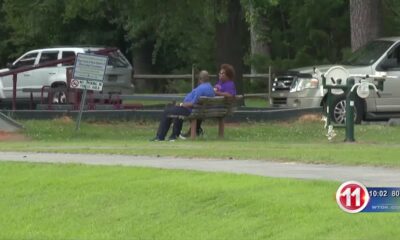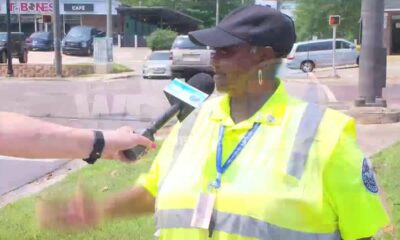Kaiser Health News
Statistical Models vs. Front-Line Workers: Who Knows Best How to Spend Opioid Settlement Cash?
Aneri Pattani
Tue, 05 Mar 2024 10:00:00 +0000
MOBILE, Ala. — In this Gulf Coast city, addiction medicine doctor Stephen Loyd announced at a January event what he called “a game-changer” for state and local governments spending billions of dollars in opioid settlement funds.
The money, which comes from companies accused of aggressively marketing and distributing prescription painkillers, is meant to tackle the addiction crisis.
But “how do you know that the money you're spending is going to get you the result that you need?” asked Loyd, who was once hooked on prescription opioids himself and has become a nationally known figure since Michael Keaton played a character partially based on him in the Hulu series “Dopesick.”
Loyd provided an answer: Use statistical modeling and artificial intelligence to simulate the opioid crisis, predict which programs will save the most lives, and help local officials decide the best use of settlement dollars.
Loyd serves as the unpaid co-chair of the Helios Alliance, a group that hosted the event and is seeking $1.5 million to create such a simulation for Alabama.
The state is set to receive more than $500 million from opioid settlements over nearly two decades. It announced $8.5 million in grants to various community groups in early February.
Loyd's audience that gray January morning included big players in Mobile, many of whom have known one another since their school days: the speaker pro tempore of Alabama's legislature, representatives from the city and the local sheriff's office, leaders from the nearby Poarch Band of Creek Indians, and dozens of addiction treatment providers and advocates for preventing youth addiction.
Many of them were excited by the proposal, saying this type of data and statistics-driven approach could reduce personal and political biases and ensure settlement dollars are directed efficiently over the next decade.
But some advocates and treatment providers say they don't need a simulation to tell them where the needs are. They see it daily, when they try — and often fail — to get people medications, housing, and other basic services. They worry allocating $1.5 million for Helios prioritizes Big Tech promises for future success while shortchanging the urgent needs of people on the front lines today.
“Data does not save lives. Numbers on a computer do not save lives,” said Lisa Teggart, who is in recovery and runs two sober living homes in Mobile. “I'm a person in the trenches,” she said after attending the Helios event. “We don't have a clean-needle program. We don't have enough treatment. … And it's like, when is the money going to get to them?”
The debate over whether to invest in technology or boots on the ground is likely to reverberate widely, as the Helios Alliance is in discussions to build similar models for other states, including West Virginia and Tennessee, where Loyd lives and leads the Opioid Abatement Council.
New Predictive Promise?
The Helios Alliance comprises nine nonprofit and for-profit organizations, with missions ranging from addiction treatment and mathematical modeling to artificial intelligence and marketing. As of mid-February, the alliance had received $750,000 to build its model for Alabama.
The largest chunk — $500,000 — came from the Poarch Band of Creek Indians, whose tribal council voted unanimously to spend most of its opioid settlement dollars to date on the Helios initiative. A state agency chipped in an additional $250,000. Ten Alabama cities and some private foundations are considering investing as well.
Stephen McNair, director of external affairs for Mobile, said the city has an obligation to use its settlement funds “in a way that is going to do the most good.” He hopes Helios will indicate how to do that, “instead of simply guessing.”
Rayford Etherton, a former attorney and consultant from Mobile who created the Helios Alliance, said he is confident his team can “predict the likely success or failure of programs before a dollar is spent.”
The Helios website features a similarly bold tagline: “Going Beyond Results to Predict Them.”
To do this, the alliance uses system dynamics, a mathematical modeling technique developed at the Massachusetts Institute of Technology in the 1950s. The Helios model takes in local and national data about addiction services and the drug supply. Then it simulates the effects different policies or spending decisions can have on overdose deaths and addiction rates. New data can be added regularly and new simulations run anytime. The alliance uses that information to produce reports and recommendations.
Etherton said it can help officials compare the impact of various approaches and identify unintended consequences. For example, would it save more lives to invest in housing or treatment? Will increasing police seizures of fentanyl decrease the number of people using it or will people switch to different substances?
And yet, Etherton cautioned, the model is “not a crystal ball.” Data is often incomplete, and the real world can throw curveballs.
Another limitation is that while Helios can suggest general strategies that might be most fruitful, it typically can't predict, for instance, which of two rehab centers will be more effective. That decision would ultimately come down to individuals in charge of awarding contracts.
Mathematical Models vs. On-the-Ground Experts
To some people, what Helios is proposing sounds similar to a cheaper approach that 39 states — including Alabama — already have in place: opioid settlement councils that provide insights on how to best use the money. These are groups of people with expertise ranging from addiction medicine and law enforcement to social services and personal experience using drugs.
Even in places without formal councils, treatment providers and recovery advocates say they can perform a similar function. Half a dozen advocates in Mobile told KFF Health News the city's top need is low-cost housing for people who want to stop using drugs.
“I wonder how much the results” from the Helios model “are going to look like what people on the ground doing this work have been saying for years,” said Chance Shaw, director of prevention for AIDS Alabama South and a person in recovery from opioid use disorder.
But Loyd, the co-chair of the Helios board, sees the simulation platform as augmenting the work of opioid settlement councils, like the one he leads in Tennessee.
Members of his council have been trying to decide how much money to invest in prevention efforts versus treatment, “but we just kind of look at it, and we guessed,” he said — the way it's been done for decades. “I want to know specifically where to put the money and what I can expect from outcomes.”
Jagpreet Chhatwal, an expert in mathematical modeling who directs the Institute for Technology Assessment at Massachusetts General Hospital, said models can reduce the risk of individual biases and blind spots shaping decisions.
If the inputs and assumptions used to build the model are transparent, there's an opportunity to instill greater trust in the distribution of this money, said Chhatwal, who is not affiliated with Helios. Yet if the model is proprietary — as Helios' marketing materials suggest its product will be — that could erode public trust, he said.
Etherton, of the Helios Alliance, told KFF Health News, “Everything we do will be available publicly for anyone who wants to look at it.”
Urgent Needs vs. Long-Term Goals
Helios' pitch sounds simple: a small upfront cost to ensure sound future decision-making. “Spend 5% so you get the biggest impact with the other 95%,” Etherton said.
To some people working in treatment and recovery, however, the upfront cost represents not just dollars, but opportunities lost for immediate help, be it someone who couldn't find an open bed or get a ride to the pharmacy.
“The urgency of being able to address those individual needs is vital,” said Pamela Sagness, executive director of the North Dakota Behavioral Health Division.
Her department recently awarded $7 million in opioid settlement funds to programs that provide mental health and addiction treatment, housing, and syringe service programs because that's what residents have been demanding, she said. An additional $52 million in grant requests — including an application from the Helios Alliance — went unfunded.
Back in Mobile, advocates say they see the need for investment in direct services daily. More than 1,000 people visit the office of the nonprofit People Engaged in Recovery each month for recovery meetings, social events, and help connecting to social services. Yet the facility can't afford to stock naloxone, a medication that can rapidly reverse overdoses.
At the two recovery homes that Mobile resident Teggart runs, people can live in a drug-free space at a low cost. She manages 18 beds but said there's enough demand to fill 100.
Hannah Seale felt lucky to land one of those spots after leaving Mobile County jail last November.
“All I had with me was one bag of clothes and some laundry detergent and one pair of shoes,” Seale said.
Since arriving, she's gotten her driver's license, applied for food stamps, and attended intensive treatment. In late January, she was working two jobs and reconnecting with her 4- and 7-year-old daughters.
After 17 years of drug use, the recovery home “is the one that's worked for me,” she said.
——————————
By: Aneri Pattani
Title: Statistical Models vs. Front-Line Workers: Who Knows Best How to Spend Opioid Settlement Cash?
Sourced From: kffhealthnews.org/news/article/opioid-settlement-cash-alabama-mathematical-models-helios/
Published Date: Tue, 05 Mar 2024 10:00:00 +0000
Did you miss our previous article…
https://www.biloxinewsevents.com/whistleblower-accuses-aledade-largest-us-independent-primary-care-network-of-medicare-fraud/
Kaiser Health News
Forget Ringing the Button for the Nurse. Patients Now Stay Connected by Wearing One.
Phil Galewitz, KFF Health News
Wed, 08 May 2024 09:00:00 +0000
HOUSTON — Patients admitted to Houston Methodist Hospital get a monitoring device about the size of a half-dollar affixed to their chest — and an unwitting role in the expanding use of artificial intelligence in health care.
The slender, battery-powered gadget, called a BioButton, records vital signs including heart and breathing rates, then wirelessly sends the readings to nurses sitting in a 24-hour control room elsewhere in the hospital or in their homes. The device's software uses AI to analyze the voluminous data and detect signs a patient's condition is deteriorating.
Hospital officials say the BioButton has improved care and reduced the workload of bedside nurses since its rollout last year.
“Because we catch things earlier, patients are doing better, as we don't have to wait for the bedside team to notice if something is going wrong,” said Sarah Pletcher, system vice president at Houston Methodist.
But some nurses fear the technology could wind up replacing them rather than supporting them — and harming patients. Houston Methodist, one of dozens of U.S. hospitals to employ the device, is the first to use the BioButton to monitor all patients except those in intensive care, Pletcher said.
“The hype around a lot of these devices is they provide care at scale for less labor costs,” said Michelle Mahon, a registered nurse and an assistant director of National Nurses United, the profession's largest U.S. union. “This is a trend that we find disturbing,” she said.
The rollout of BioButton is among the latest examples of hospitals deploying technology to improve efficiency and address a decades-old nursing shortage. But that transition has raised its own concerns, including about the device's use of AI; polls show the public is wary of health providers relying on it for patient care.
In December 2022 the FDA cleared the BioButton for use in adult patients who are not in critical care. It is one of many AI tools now used by hospitals for tasks like reading diagnostic imaging results.
In 2023, President Joe Biden directed the Department of Health and Human Services to develop a plan to regulate AI in hospitals, including by collecting reports of patients harmed by its use.
The leader of BioIntelliSense, which developed the BioButton, said its device is a huge advance compared with nurses walking into a room every few hours to measure vital signs. “With AI, you now move from ‘I wonder why this patient crashed' to ‘I can see this crash coming before it happens and intervene appropriately,'” said James Mault, CEO of the Golden, Colorado-based company.
The BioButton stays on the skin with an adhesive, is waterproof, and has up to a 30-day battery life. The company says the device — which allows providers to quickly notice deteriorating health by recording more than 1,000 measurements a day per patient — has been used on more than 80,000 hospital patients nationwide in the past year.
Hospitals pay BioIntelliSense an annual subscription fee for the devices and software.
Houston Methodist officials would not reveal how much the hospital pays for the technology, though Pletcher said it equates to less than a cup of coffee a day per patient.
For a hospital system that treats thousands of patients at a time — Houston Methodist has 2,653 non-ICU beds at its eight Houston-area hospitals — such an investment could still translate to millions of dollars a year.
Hospital officials say they have not made any changes in nurse staffing and have no plans to because of implementing the BioButton.
Inside the hospital's control center for virtual monitoring on a recent morning, about 15 nurses and technicians dressed in scrubs sat in front of large monitors showing the health status of hundreds of patients they were assigned to monitor.
A red checkmark next to a patient's name signaled the AI software had found readings trending outside normal. Staff members could click into a patient's medical record, showing patients' vital signs over time and other medical history. These virtual nurses, if you will, could contact nurses on the floor by phone or email, or even dial directly into the patient's room via video call.
Nutanben Gandhi, a technician who was watching 446 patients on her monitor that morning, said that when she gets an alert, she looks at the patient's health record to see if the anomaly can be easily explained by something in the patient's condition or if she needs to contact nurses on the patient's floor.
Oftentimes an alert can be easily dismissed. But identifying signs of deteriorating health can be tough, said Steve Klahn, Houston Methodist's clinical director of virtual medicine.
“We are looking for a needle in a haystack,” he said.
Donald Eustes, 65, was admitted to Houston Methodist in March for prostate cancer treatment and has since been treated for a stroke. He is happy to wear the BioButton.
“You never know what can happen here, and having an extra set of eyes looking at you is a good thing,” he said from his hospital bed. After being told the device uses AI, the Montgomery, Texas, man said he has no problem with its helping his clinical team. “This sounds like a good use of artificial intelligence.”
Patients and nurses alike benefit from remote monitoring like the BioButton, said Pletcher of Houston Methodist.
The hospital has placed small cameras and microphones inside all patient rooms enabling nurses outside to communicate with patients and perform tasks such as helping with patient admissions and discharge instructions. Patients can include family members on the remote calls with nurses or a doctor, she said.
Virtual technology frees up on-duty nurses to provide more hands-on help, such as starting an intravenous line, Pletcher said. With the BioButton, nurses can wait to take routine vital signs every eight hours instead of every four, she said.
Pletcher said the device reduces nurses' stress in monitoring patients and allows some to work more flexible hours because virtual care can be done from home rather than coming to the hospital. Ultimately it helps retain nurses, not drive them away, she said.
Sheeba Roy, a nurse manager at Houston Methodist, said some members of the nursing staff were nervous about relying on the device and not checking patients' vital signs as often themselves. But testing has shown the device provides accurate information.
“After we implemented it, the staff loves it,” Roy said.
Serena Bumpus, chief executive officer of the Texas Nurses Association, said her concern with any technology is that it can be more burdensome on nurses and take away time with patients.
“We have to be hypervigilant in ensuring that we are not leaning on this to replace the ability of nurses to critically think and assess patients and validate what this device is telling us is true,” Bumpus said.
Houston Methodist this year plans to send the BioButton home with patients so the hospital can better track their progress in the weeks after discharge, measuring the quality of their sleep and checking their gait.
“We are not going to need less nurses in health care, but we have limited resources and we have to use those as thoughtfully as we can,” Pletcher said. “Looking at projected demand and seeing the supply we have coming, we will not have enough to meet demand, so anything we can do to give time back to nurses is a good thing.”
——————————
By: Phil Galewitz, KFF Health News
Title: Forget Ringing the Button for the Nurse. Patients Now Stay Connected by Wearing One.
Sourced From: kffhealthnews.org/news/article/hospital-artificial-intelligence-patient-monitoring-biobutton-houston/
Published Date: Wed, 08 May 2024 09:00:00 +0000
Did you miss our previous article…
https://www.biloxinewsevents.com/they-were-shot-at-the-super-bowl-parade-and-might-have-bullets-in-their-bodies-forever/
Kaiser Health News
They Were Shot at the Super Bowl Parade — And Might Have Bullets in Their Bodies Forever
Bram Sable-Smith and Peggy Lowe, KCUR
Wed, 08 May 2024 09:00:00 +0000
James Lemons, 39, wants the bullet removed from his thigh so he can go back to work.
Sarai Holguin, a 71-year-old woman originally from Mexico, has accepted the bullet lodged near her knee as her “compa” — a close friend.
The Injured
They Were Injured at the Super Bowl Parade. A Month Later, They Feel Forgotten.
In the first of our series “The Injured,” a Kansas family remembers Valentine's Day as the beginning of panic attacks, life-altering trauma, and waking to nightmares of gunfire. Thrown into the spotlight by the shootings, they wonder how they will recover.
Mireya Nelson, 15, was hit by a bullet that went through her jaw and broke her shoulder, where fragments remain. She'll live with them for now, while doctors monitor lead levels in her blood for at least two years.
Nearly three months after the Kansas City Chiefs Super Bowl parade shooting left at least 24 people injured, recovery from those wounds is intensely personal and includes a surprising gray area in medicine: whether the bullets should be removed.
Medical protocol offers no clear answer. A 2016 survey of surgeons found that only about 15% of respondents worked at medical facilities that had policies on bullet removal. Doctors in the U.S. often leave bullets buried deep in a person's body, at least at first, so as not to cause further trauma.
But as gun violence has emerged as a public health epidemic, some researchers wonder if that practice is best. Some of the wounded, like James Lemons, are left in a precarious place.
“If there's a way to get it out, and it's safely taken out, get it out of the person,” Lemons said. “Make that person feel more secure about themselves. And you're not walking around with that memory in you.”
Lemons, Holguin, and Nelson are coping in very different ways.
Pain Became a Problem
Three days after the Chiefs won the Super Bowl, Lemons drove the 37 miles from Harrisonville, Missouri, to downtown Kansas City to celebrate the victory. The warehouse worker was carrying his 5-year-old daughter, Kensley, on his shoulders when he felt a bullet enter the back of his right thigh.
Gunfire erupted in the area packed with revelers, prosecutors later said, after a “verbal confrontation” between two groups. Detectives found “multiple 9mm and .40 caliber spent shell casings” at the scene. Lemons said he understood immediately what was happening.
“I know my city. We're not shooting off fireworks,” he said.
Lemons shielded Kensley's face as they fell to the ground so she wouldn't hit the concrete. His first thought was getting his family — also including his wife, Brandie; 17-year-old daughter, Kallie; and 10-year-old son, Jaxson — to safety.
“I'm hit. But don't worry about it,” Lemons recalled telling Brandie. “We gotta go.”
He carried Kensley on his shoulders as the family walked a mile to their car. His leg bled through his pants at first then stopped, he said. It burned with pain. Brandie insisted on driving him to the hospital but traffic was at a standstill so she put on her hazard lights and drove on the wrong side of the road.
“She's like: ‘I'm getting you to a hospital. I'm tired of people being in my way,'” Lemons recalled. “I've never seen my wife like that. I'm looking at her like, ‘That's kinda sexy.'”
Lemons clapped and smiled at his wife, he said, to which she replied, “What are you smiling for? You just got shot.” He stayed in quiet admiration until they were stopped by a sheriff, who summoned an ambulance, Lemons said.
He was taken to the emergency room at University Health, which admitted 12 patients from the rally, including eight with gunshot wounds. Imaging showed the bullet barely missed an artery, Lemons said. Doctors cleansed the wound, put his leg in a brace, and told him to come back in a week. The bullet was still in his leg.
“I was a little baffled by it, but I was like, ‘OK, whatever, I'll get out of here,'” Lemons recalled.
When he returned, doctors removed the brace but explained they often leave bullets and fragments in the body — unless they grow too painful.
“I get it, but I don't like that,” Lemons said. “Why wouldn't you take it out if you could?”
University Health spokesperson Leslie Carto said the hospital can't comment on individual patient care because of federal privacy laws.
Surgeons typically do remove bullets when they encounter them during surgery or they are in dangerous locations, like in the spinal canal or risking damage to an organ, said Brendan Campbell, a pediatric surgeon at Connecticut Children's.
Campbell also chairs the Injury Prevention and Control Committee of the American College of Surgeons' Committee on Trauma, which works on firearm injury prevention.
LJ Punch, a trauma surgeon by training and the founder of the Bullet Related Injury Clinic in St. Louis, said the origins of trauma care also help explain why bullets are so often left.
“Trauma care is war medicine,” Punch said. “It is set to be ready at any moment and any time, every day, to save a life. It is not equipped to take care of the healing that needs to come after.”
In the survey of surgeons, the most common reasons given for removing a bullet were pain, a palpable bullet lodged near the skin, or an infection. Far less common were lead poisoning and mental health concerns such as post-traumatic stress disorder and anxiety.
What patients wanted also affected their decisions, the surgeons said.
Lemons wanted the bullet out. The pain it caused in his leg radiated up from his thigh, making it difficult to move for more than an hour or two. Working his warehouse job was impossible.
“I gotta lift 100 pounds every night,” Lemons recalled telling his doctors. “I gotta lift my child. I can't work like this.”
He has lost his income and his health insurance. Another stroke of bad luck: The family's landlord sold their rental home soon after the parade, and they had to find a new place to live. This house is smaller, but it was important to keep the kids in the same school district with their friends, Lemons said in an interview in Kensley's pink bedroom, the quietest spot to talk.
They've borrowed money and raised $6,500 on GoFundMe to help with the deposit and car repairs, but the parade shooting has left the family in a deep financial hole.
Without insurance, Lemons worried he couldn't afford to have the bullet removed. Then he learned his surgery would be paid for by donations. He set up an appointment at a hospital north of the city, where a surgeon took measurements on his X-ray and explained the procedure.
“I need you to be involved as much as I'm going to be involved,” he remembered being told, “because — guess what — this ain't my leg.”
The surgery is scheduled for this month.
‘We Became Friends'
Sarai Holguin isn't much of a Chiefs fan, but she agreed to go to the rally at Union Station to show her friend the best spot to see the players on stage. It was an unseasonably warm day, and they were standing near an entrance where lots of police were stationed. Parents had babies in strollers, kids were playing football, and she felt safe.
A little before 2 p.m., Holguin heard what she thought were fireworks. People started running away from the stage. She turned to leave, trying to find her friend, but felt dizzy. She didn't know she'd been shot. Three people quickly came to her aid and helped her to the ground, and a stranger took off his shirt and made a tourniquet to put on her left leg.
Holguin, a native of Puebla, Mexico, who became a U.S. citizen in 2018, had never seen so much chaos, so many paramedics working under such pressure. They were “anonymous heroes,” she said.
She saw them working on Lisa Lopez-Galvan, a well-known DJ and 43-year-old mother of two. Lopez-Galvan died at the scene, and was the sole fatality at the parade. Holguin was rushed to University Health, about five minutes from Union Station.
There doctors performed surgery, leaving the bullet in her leg. Holguin awoke to more chaos. She had lost her purse, along with her cellphone, so she couldn't call her husband, Cesar. She had been admitted to the hospital under an alias — a common practice at medical centers to begin immediate care.
Her husband and daughter didn't find her until about 10 p.m. — roughly eight hours after she'd been shot.
“It has been a huge trauma for me,” Holguin said through an interpreter. “I was injured and at the hospital without doing anything wrong. [The rally] was a moment to play, to relax, to be together.”
Holguin was hospitalized for a week, and two more outpatient surgeries quickly followed, mostly to remove dead tissue around the wound. She wore a wound VAC, or vacuum-assisted closure device, for several weeks and had medical appointments every other day.
Campbell, the trauma surgeon, said wound VACs are common when bullets damage tissue that isn't easily reconstructed in surgery.
“It's not just the physical injuries,” Campbell said. “Many times it's the emotional, psychological injuries, which many of these patients take away as well.”
The bullet remains near Holguin's knee.
“I'm going to have it for the rest of my life,” she said, saying she and the bullet became “compas,” close friends.
“We became friends so that she doesn't do any bad to me anymore,” Holguin said with a smile.
Punch, of the Bullet Related Injury Clinic in St. Louis, said some people like Holguin are able to find a way to psychically live with bullets that remain.
“If you're able to make a story around what that means for that bullet to be in your body, that gives you power; that gives you agency and choice,” Punch said.
Holguin's life changed in an instant: She's using a walker to get around. Her foot, she said, acts “like it had a stroke” — it dangles, and it's difficult to move her toes.
The most frustrating consequence is that she cannot travel to see her 102-year-old father, still in Mexico. She has a live camera feed on her phone to see him, but that doesn't offer much comfort, she said, and thinking about him brings tears.
She was told at the hospital that her medical bills would be taken care of, but then lots of them came in the mail. She tried to get victim assistance from the state of Missouri, but all the forms she had were in English, which made them difficult to comprehend. Renting the wound VAC alone cost $800 a month.
Finally she heard that the Mexican Consulate in Kansas City could help, and the consul pointed her to the Jackson County Prosecutor's Office, with which she registered as an official victim. Now all of her bills are being paid, she said.
Holguin isn't going to seek mental health treatment, as she believes one must learn to live with a given situation or it will become a burden.
“I have processed this new chapter in my life,” Holguin said. “I have never given up and I will move on with God's help.”
‘I Saw Blood on My Hands'
Mireya Nelson was late to the parade. Her mother, Erika, told her she should leave early, given traffic and the million people expected to crowd into downtown Kansas City, but she and her teenage friends ignored that advice. The Nelsons live in Belton, Missouri, about a half hour south of the city.
Mireya wanted to hold the Super Bowl trophy. When she and her three friends arrived, the parade that had moved through downtown was over and the rally at Union Station had begun. They were stuck in the large crowd and quickly grew bored, Mireya said.
Getting ready to leave, Mireya and one of her friends were trying to call the driver of their group, but they couldn't get cell service in the large crowd.
Amid the chaos of people and noise, Mireya suddenly fell.
“I saw blood on my hands. So then I knew I got shot. Yeah, and I just crawled to a tree,” Mireya said. “I actually didn't know where I got shot at, at first. I just saw blood on my hands.”
The bullet grazed Mireya's chin, shot through her jaw, broke her shoulder, and left through her arm. Bullet fragments remain in her shoulder. Doctors decided to leave them because Mireya had already suffered so much damage.
Mireya's mother supports that decision, for now, noting they were just “fragments.”
“I think if it's not going to harm her the rest of her life,” Erika said, “I don't want her to keep going back in the hospital and getting surgery. That's more trauma to her and more recovery time, more physical therapy and stuff like that.”
Bullet fragments, particularly ones only skin-deep, often push their way out like splinters, according to Punch, although patients aren't always told about that. Moreover, Punch said, injuries caused by bullets extend beyond those with damaged tissue to the people around them, like Erika. He called for a holistic approach to recover from all the trauma.
“When people stay in their trauma, that trauma can change them for a lifetime,” Punch said.
Mireya will be tested for lead levels in her blood for at least the next two years. Her levels are fine now, doctors told the family, but if they get worse she will need surgery to remove the fragments, her mother said.
Campbell, the pediatric surgeon, said lead is particularly concerning for young children, whose developing brains make them especially vulnerable to its harmful effects. Even a tiny amount of lead — 3.5 micrograms per deciliter — is enough to report to state health officials, according to the Centers for Disease Control and Prevention.
Mireya talks about cute teenage boys' being “fine” but also still wears Cookie Monster pajamas. She appears confused by the shootings, by all the attention at home, at school, from reporters. Asked how she feels about the fragments in her arm, she said, “I don't really care for them.”
Mireya was on antibiotics for 10 days after her hospital stay because doctors feared there was bacteria in the wound. She has had physical therapy, but it's painful to do the exercises. She has a scar on her chin. “A dent,” she said, that's “bumpy.”
“They said she was lucky because if she wouldn't have turned her head in a certain way, she could be gone,” Erika said.
Mireya faces a psychiatric evaluation and therapy appointments, though she doesn't like to talk about her feelings.
So far, Erika's insurance is paying the medical bills, though she hopes to get some help from the United Way's #KCStrong fund, which raised nearly $1.9 million, or a faith-based organization called Unite KC.
Erika doesn't want a handout. She has a job in health care and just got a promotion.
The bullet has changed the family's life in big ways. It is part of their conversation now. They talk about how they wish they knew what kind of ammunition it was, or what it looked like.
“Like, I wanted to keep the bullet that went through my arm,” Mireya said. “I want to know what kind of bullet it was.” That brought a sigh from her mom, who said her daughter had watched too many episodes of “Forensic Files.”
Erika beats herself up about the wound, because she couldn't protect her daughter at the parade.
“It hits me hard because I feel bad because she begged me to get off work and I didn't go there because when you have a new position, you can't just take off work,” Erika said. “Because I would have took the bullet. Because I would do anything. It's mom mode.”
——————————
By: Bram Sable-Smith and Peggy Lowe, KCUR
Title: They Were Shot at the Super Bowl Parade — And Might Have Bullets in Their Bodies Forever
Sourced From: kffhealthnews.org/news/article/the-injured-super-bowl-parade-kansas-city-bullets-still-bodies/
Published Date: Wed, 08 May 2024 09:00:00 +0000
Did you miss our previous article…
https://www.biloxinewsevents.com/amgen-plows-ahead-with-costly-highly-toxic-cancer-dosing-despite-fda-challenge/
Kaiser Health News
Amgen Plows Ahead With Costly, Highly Toxic Cancer Dosing Despite FDA Challenge
Arthur Allen
Tue, 07 May 2024 09:00:00 +0000
When doctors began using the drug sotorasib in 2021 with high expectations for its innovative approach to attacking lung cancer, retired medical technician Don Crosslin was an early beneficiary. Crosslin started the drug that July. His tumors shrank, then stabilized.
But while the drug has helped keep him alive, its side effects have gradually narrowed the confines of his life, said Crosslin, 76, who lives in Ocala, Florida: “My appetite has been minimal. I'm very weak. I walk my dogs and get around a bit, but I haven't been able to golf since last July.”
He wonders whether he'd do better on a lower dose, “but I do what my oncologist tells me to do,” Crosslin said. Every day, he takes eight of the 120-milligram pills, sold under Amgen's brand name Lumakras.
Crosslin's concern lies at the heart of an FDA effort to make cancer drugs less toxic and more effective. Cancer drug trials are structured to promote high doses, which then become routine patient care. In the face of evidence that thousands of patients become so ill that they skip doses or stop taking the drugs — thereby risking resurgence of their cancers — the FDA has begun requiring companies to pinpoint the right dosage before they reach patients.
The initiative, Project Optimus, launched in 2021 just as Amgen was seeking to market sotorasib. At the time, the FDA's leading cancer drug regulator, Richard Pazdur, co-authored an editorial in the New England Journal of Medicine that said Amgen's trials of the $20,000-a-month drug were “hampered by a lack of robust dose exploration.”
The FDA conditionally approved sotorasib but required Amgen to conduct a study comparing the labeled dosage of 960 mg with a dosage of 240 mg. The trial, published in November, showed that the 960-mg dose may have given patients a month more of life, on average, but caused more severe side effects than the lower dose.
Amgen is keeping the 960-mg dosage as it conducts further tests to get final approval for the drug, spokesperson Elissa Snook said, adding that the dose showed superiority in one study. Whether medically justified or not, the heavier dosage allows the company to protect 75% of its revenue from the drug, which brought in nearly $200 million in the United States last year.
And there appears to be nothing the FDA can do about it.
“There's a gap in FDA's authority that results in patients getting excess doses of a drug at excess costs,” said Mark Ratain, a University of Chicago oncologist who has pushed for more accurate cancer drug dosing. “We should do something about this.”
Deciding on Dosage
It may be too late for the FDA to change the sotorasib dosage, although in principle it could demand a new regimen before granting final approval, perhaps in 2028. Under Project Optimus, however, the agency is doing something about dosage guidelines for future drugs. It is stressing dose optimization in its meetings with companies, particularly as they prepare to test drugs on patients for the first time, spokesperson Lauren-Jei McCarthy said.
“When you go in front of FDA with a plan to approve your drug now, they are going to address dosing studies,” said Julie Gralow, chief medical officer of the American Society of Clinical Oncology. “A lot of companies are struggling with this.”
That's largely because the new requirements add six months to a year and millions in drug development costs, said Julie Bullock, a former FDA drug reviewer who advocated for more extensive dosing studies and is now senior vice president at Certara, a drug development consultancy.
In part, Project Optimus represents an effort to manage the faults of the FDA's accelerated approval process, begun in 1992. While the process gets innovative drugs to patients more quickly, some medicines have proved lackluster or had unacceptable side effects.
That's especially true of the newer pills to treat cancer, said Donald Harvey, an Emory University pharmacology professor, who has led or contributed to more than 100 early-phase cancer trials.
A study released last month in the Journal of the American Medical Association showed that 41% of the cancer drugs granted accelerated approval from 2013 to 2017 did not improve overall survival or quality of life after five years.
Many of these drugs flop because they must be given at toxic dosages to have any effect, Harvey said, adding that sotorasib might work better if the company had found an appropriate dosage earlier on.
“Sotorasib is a poster child for incredibly bad development,” Harvey said. The drug was the first to target the KRAS G12C mutation, which drives about 15% of lung cancers and was considered “undruggable” until University of California-San Francisco chemist Kevan Shokat figured out how to attack it in 2012.
Given the specificity of sotorasib's target, Harvey said, Amgen could have found a lower dosage. “Instead, they followed the old model and said, ‘We're going to push the dose up until we see a major side effect.' They didn't need to do that. They just needed more experience with a lower dose.”
The 960-mg dose “is really tough on patients,” said Yale University oncologist and assistant professor Michael Grant. “They get a lot of nausea and other GI side effects that are not pleasant. It hurts their quality of life.”
The FDA noted in its review of sotorasib that in phase 1 studies tumors shrank when exposed to as little as a fifth of the 960-mg daily dose Amgen selected. At all doses tested in that early trial, the drug reached roughly the same concentrations in the blood, which suggested that at higher doses the drug was mostly just intensifying side effects like diarrhea, vomiting, and mouth sores.
For most classes of drugs, companies spend considerable time in phases 1 and 2 of development, homing in on the right dosage. “No one would think of dosing a statin or antibiotic at the highest tolerable dose,” Ratain said.
Things are different in cancer drug creation, whose approach originated with chemotherapy, which damages as many cancer cells as possible, wrecking plenty of healthy tissue in the bargain. Typically, a company's first series of cancer drug trials involve escalating doses in small groups of patients until something like a quarter of them get seriously ill. That “maximum tolerated dose” is then employed in more advanced clinical trials, and goes on the drug's label. Once a drug is approved, a doctor can “go off-label” and alter the dosage, but most are leery of doing so.
Patients can find the experience rougher than advertised. During clinical trials, the side effects of the cancer drug osimertinib (Tagrisso) were listed as tolerable and manageable, said Jill Feldman, a lung cancer patient and advocate. “That killed me. After two months on that drug, I had lost 15 pounds, had sores in my mouth and down my throat, stomach stuff. It was horrible.”
Some practitioners, at least, have responded to the FDA's cues on sotorasib. In the Kaiser Permanente health system, lung cancer specialists start with a lower dose of the drug, spokesperson Stephen Shivinsky said.
Smaller Doses — And Revenue
Amgen was clearly aware of the advantages of the 240-mg dosage before it sought FDA approval: It filed a provisional patent application on that dosage before the agency gave breakthrough approval for the drug at 960 mg. The company doesn't appear to have disclosed the patent filing to investors or the FDA. McCarthy said the FDA was prohibited by law from discussing the particulars of its sotorasib regulation plans.
Switching to a 240-mg dosage could register a huge hit to Amgen's revenue. The company markets the drug at more than $20,000 for a month of 960-mg daily doses. Each patient who could get by with a quarter of that would trim the company's revenue by roughly $180,000 a year.
Amgen declined to comment on the patent issue or to make an official available to discuss the dosage and pricing issues.
Crosslin, who depends on Social Security for his income, couldn't afford the $3,000 a month that Medicare required him to pay for sotorasib, but he has received assistance from Amgen and a charity that covers costs for patients below a certain income.
While the drug has worked well for Crosslin and other patients, its overall modest impact on lung cancer suggests that $5,000, rather than $20,000, might be a more appropriate price, Ratain said.
In the company's phase 3 clinical trial for advanced lung cancer patients, sotorasib kept patients alive for about a month longer than docetaxel, the current, highly toxic standard of care. Docetaxel is a generic drug for which Medicare pays about $1 per injection. The trial was so unconvincing that the FDA sent Amgen back to do another.
Ratain, a staunch critic of Amgen's handling of sotorasib, told Centers for Medicare & Medicaid Services officials at a recent meeting that they should pay for sotorasib on a basis of 240 mg per day. But CMS would do that only “if there is a change in the drug's FDA-approved dosage,” spokesperson Aaron Smith said.
Drug companies generally don't want to spend money on trials like the one the FDA ordered on sotorasib. In 2018, Ratain and other researchers used their institutions' funding to conduct a dosing trial on the prostate cancer drug abiraterone, marketed under the brand name Zytiga by Johnson & Johnson. They found that taking one 250-mg pill with food was just as effective as taking four on an empty stomach, as the label called for.
Although J&J hasn't changed the Zytiga label, the evidence generated in that trial was strong enough for the standards-setting National Comprehensive Cancer Network to change its recommendations.
Post-marketing studies like that one are hard to conduct, Emory's Harvey said. Patients are reluctant to join a trial in which they may have to take a lower dosage, since most people tend to believe “the more the better,” he said.
“It's better for everyone to find the right dose before a drug is out on the market,” Harvey said. “Better for the patient, and better for the company, which can sell more of a good drug if the patients aren't getting sick and no longer taking it.”
——————————
By: Arthur Allen
Title: Amgen Plows Ahead With Costly, Highly Toxic Cancer Dosing Despite FDA Challenge
Sourced From: kffhealthnews.org/news/article/amgen-cancer-drug-sotorasib-lumakras-high-dosage-fda-dosing-trials/
Published Date: Tue, 07 May 2024 09:00:00 +0000
-
SuperTalk FM7 days ago
Driver’s education set to become mandatory in Mississippi as bill passes
-
SuperTalk FM5 days ago
State approves $160M to expand Highway 7 to four lanes in Lafayette County
-
SuperTalk FM2 days ago
Legislation outlawing ‘squatted’ vehicles in Mississippi signed into law
-
Mississippi Today4 days ago
On this day in 1917
-
Mississippi News3 days ago
LCSO wants people aware of a scam circling the area
-
228Sports2 days ago
PRC’s Bats Come Alive Late As Blue Devils Beat Picayune To Advance To 6A South State Title Series
-
Mississippi News3 days ago
Winston Co. Sheriff’s Office investigates shooting at Dave’s Club
-
Mississippi News7 days ago
Altercation at Mississippi police department leads to officer-involved shooting





































